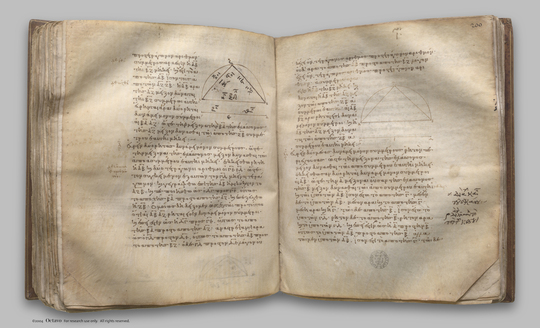index prev next | digilib folio 204

To find two medial straight lines commensurable in square only, containing a rational rectangle, and such that the square on the greater is greater than the square on the less by the square on a straight line commensurable in length with the greater.
| Εὑρεῖν δύο μέσας δυνάμει μόνον συμμέτρους ῥητὸν περιεχούσας, ὥστε τὴν μείζονα τῆς ἐλάσσονος μεῖζον δύνασθαι τῷ ἀπὸ συμμέτρου ἑαυτῇ μήκει. Ἐκκείσθωσαν δύο ῥηταὶ δυνάμει μόνον σύμμετροι αἱ Α, Β, ὥστε τὴν Α μείζονα οὖσαν τῆς ἐλάσσονος τῆς Β μεῖζον δύνασθαι τῷ ἀπὸ συμμέτρου ἑαυτῇ μήκει. καὶ τῷ ὑπὸ τῶν Α, Β ἴσον ἔστω τὸ ἀπὸ τῆς Γ. μέσον δὲ τὸ ὑπὸ τῶν Α, Β: μέσον ἄρα καὶ τὸ ἀπὸ τῆς Γ: μέση ἄρα καὶ ἡ Γ. τῷ δὲ ἀπὸ τῆς Β ἴσον ἔστω τὸ ὑπὸ τῶν Γ, Δ. ῥητὸν δὲ τὸ ἀπὸ τῆς Β: ῥητὸν ἄρα καὶ τὸ ὑπὸ τῶν Γ, Δ. καὶ ἐπεί ἐστιν ὡς ἡ Α πρὸς τὴν Β, οὕτως τὸ ὑπὸ τῶν Α, Β πρὸς τὸ ἀπὸ τῆς Β, ἀλλὰ τῷ μὲν ὑπὸ τῶν Α, Β ἴσον ἐστὶ τὸ ἀπὸ τῆς Γ, τῷ δὲ ἀπὸ τῆς Β ἴσον τὸ ὑπὸ τῶν Γ, Δ, ὡς ἄρα ἡ Α πρὸς τὴν Β, οὕτως τὸ ἀπὸ τῆς Γ πρὸς τὸ ὑπὸ τῶν Γ, Δ. ὡς δὲ τὸ ἀπὸ τῆς Γ πρὸς τὸ ὑπὸ τῶν Γ, Δ, οὕτως ἡ Γ πρὸς τὴν Δ: καὶ ὡς ἄρα ἡ Α πρὸς τὴν Β, οὕτως ἡ Γ πρὸς τὴν Δ. σύμμετρος δὲ ἡ Α τῇ Β δυνάμει μόνον: σύμμετρος ἄρα καὶ ἡ Γ τῇ Δ δυνάμει μόνον. καί ἐστι μέση ἡ Γ: μέση ἄρα καὶ ἡ Δ. καὶ ἐπεί ἐστιν ὡς ἡ Α πρὸς τὴν Β, ἡ Γ πρὸς τὴν Δ, ἡ δὲ Α τῆς Β μεῖζον δύναται τῷ ἀπὸ συμμέτρου ἑαυτῇ, καὶ ἡ Γ ἄρα τῆς Δ μεῖζον δύναται τῷ ἀπὸ συμμέτρου ἑαυτῇ. Εὕρηνται ἄρα δύο μέσαι δυνάμει μόνον σύμμετροι αἱ Γ, Δ ῥητὸν περιέχουσαι, καὶ ἡ Γ τῆς Δ μεῖζον δύναται τῷ ἀπὸ συμμέτρου ἑαυτῇ μήκει. Ὁμοίως δὴ δειχθήσεται καὶ τῷ ἀπὸ ἀσυμμέτρου, ὅταν ἡ Α τῆς Β μεῖζον δύνηται τῷ ἀπὸ ἀσυμμέτρου ἑαυτῇ. | To find two medial straight lines commensurable in square only, containing a rational rectangle, and such that the square on the greater is greater than the square on the less by the square on a straight line commensurable in length with the greater. Let there be set out two rational straight lines A, B commensurable in square only and such that the square on A, being the greater, is greater than the square on B the less by the square on a straight line commensurable in length with A. [X. 29] And let the square on C be equal to the rectangle A, B. Now the rectangle A, B is medial; [X. 21] therefore the square on C is also medial; therefore C is also medial. [X. 21] Let the rectangle C, D be equal to the square on B. Now the square on B is rational; therefore the rectangle C, D is also rational. And since, as A is to B, so is the rectangle A, B to the square on B, while the square on C is equal to the rectangle A, B, and the rectangle C, D is equal to the square on B, therefore, as A is to B, so is the square on C to the rectangle C, D. But, as the square on C is to the rectangle C, D, so is C to D; therefore also, as A is to B, so is C to D. But A is commensurable with B in square only; therefore C is also commensurable with D in square only. [X. 11] And C is medial; therefore D is also medial. [X. 23, addition] And since, as A is to B, so is C to D, and the square on A is greater than the square on B by the square on a straight line commensurable with A, therefore also the square on C is greater than the square on D by the square on a straight line commensurable with C. [X. 14] Therefore two medial straight lines C, D, commensurable in square only and containing a rational rectangle, have been found, and the square on C is greater than the square on D by the square on a straight line commensurable in length with C. |